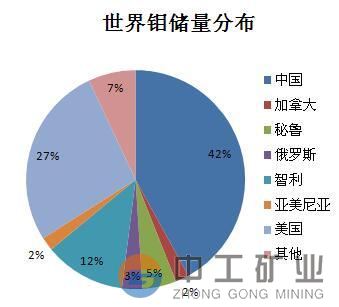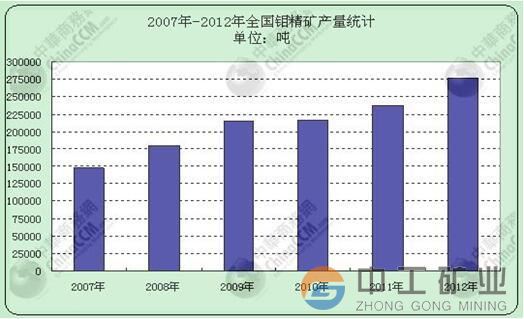Molybdenum resource reserve distribution and output
Release time:
2017-01-19 00:00
Molybdenum resource distribution
The average content of molybdenum in the crust is about 0.00011%. There are about 20 kinds of molybdenum ores found, among which molybdenite is the most valuable one, followed by tungsten phase calcium ore, iron platinum ore, color molybdenum lead ore, platinum copper ore, etc. According to the data released by the US Geological Survey in 2015, the global molybdenum resource reserves are about 11 million tons, and the proven reserves are about 19.4 million tons.


According to the data released by the US Geological Survey in 2015, the global molybdenum resource reserves are about 11 million tons. China is the country with the most abundant molybdenum resources in the world, with 4.3 million tons of molybdenum resource reserves, followed by the United States (2.7 million tons) and Chile (1.8 million tons). The molybdenum resource reserves of the three countries account for about 80% of the global total reserves. Other countries with rich molybdenum resources are Peru (450000 tons), Canada (260000 tons), Russia (250000 tons), Australia (200000 tons), Mongolia (160000 tons), Armenia (150000 tons), Mexico (130000 tons), Kazakhstan (130000 tons), Kyrgyzstan (100000 tons), Türkiye (100000 tons), Uzbekistan (60000 tons) and Iran (50000 tons).
Distribution of molybdenum resources in China
China is one of the countries with the richest molybdenum mineral resources in the world. According to the data released by the Ministry of Land and Resources, as of the end of 2013, the molybdenum mineral reserves in China were 26.202 million tons (metal content). In 2014, the newly identified resource reserves of China's molybdenum mines were 1.066 million tons (metal content), so by 2014, the identified resource reserves of China's molybdenum mines had reached 27.268 million tons (metal content). In addition, since 2011, three 2 million ton molybdenum mines, including Shapinggou in Anhui Province, have been found in China, and China, as the world's largest country in molybdenum resources, has a more stable resource base.

In terms of the distribution of molybdenum deposits in China, the central and southern regions account for 35.7% of the total molybdenum reserves in China, ranking first; It is followed by 19.5% in the northeast, 13.9% in the northwest, 12% in the north, and only 4% in the southwest. In terms of provinces (regions), Henan is the largest, accounting for 30.1% of the total molybdenum reserves in China, followed by Shaanxi accounting for 13.6% and Jilin accounting for 13%; In addition, Shandong accounts for 6.7%, Hebei accounts for 4%, Liaoning accounts for 3.7%, and Inner Mongolia accounts for 3.6%. The total reserves of the above eight provinces (districts) account for 81.1% of the total molybdenum reserves in China, of which the top three accounts for 56.5%.
Characteristics of molybdenum resources in china
An important feature of molybdenum deposits in China is that there are many large deposits. Jinduicheng, Shaanxi, Luanchuan, Henan, Yangjiazhangzi, Liaoning, and Daheishan, Jilin are all world-class large molybdenum deposits. Porphyry molybdenum deposit and porphyry skarn molybdenum deposit are the most important deposit types. The former is Jinduicheng in Shaanxi, Dexing in Jiangxi, and the latter is Nannihu molybdenum deposit in Henan; Skarn type, carbonate vein type and quartz vein type take second place; Sedimentary molybdenum uranium vanadium nickel deposits have great potential value, while pegmatite vein molybdenum deposits have no industrial significance. From the perspective of formation age, most molybdenum deposits were formed in Mesozoic era, which were the products of Yanshanian tectonic magmatic activity, except a few formed in late Paleozoic and Cenozoic.
China's molybdenum resources have the following characteristics:
1. Low grade. The first feature of China's molybdenum deposits is that although there are many proven reserves, the grade is significantly lower than that of the world's major molybdenum resource countries (the United States and Chile), and most of them are low-grade deposits. The reserves of low-grade deposits with an average grade of less than 0.1% in the mining area account for 65% of the total reserves, of which 10% are less than 0.05%. The reserves of medium grade (0.1% ~ 0.2%) deposits account for 30% of the total reserves, the reserves of rich grade (0.2% ~ 0.3%) deposits account for 4% of the total reserves, and the reserves of rich ores with a grade greater than 0.3% account for only 1% of the total reserves.
2. There are many associated beneficial components with high economic value. According to statistics, as a single mineral deposit, molybdenum reserves only account for 14% of the total molybdenum reserves in China; As the main mineral, there are also associated mineral deposits with other useful components, whose reserves account for 64% of the total reserves; Associated with copper, tungsten, tin and other metals, the reserves account for 22% of the total reserves.
3. Large scale, and mostly suitable for open mining. According to statistics, the reserves of large molybdenum mines with reserves of more than 100,000 tons account for 76% of the total reserves of the country; Medium sized mineral deposits with reserves of 10000~100000 tons account for 20% of the total reserves; Molybdenum deposits suitable for open mining account for 64% of the total reserves. Most large deposits can be open mined, and the particles of molybdenite are often relatively coarse, which is easy to select. In terms of ore types, the proven molybdenum ore reserves in China are mainly molybdenum sulfide ores that are easy to use, accounting for 99% of the total reserve of molybdenum ores, while molybdenum oxide ores, mixed molybdenum ores and molybdenum ores of unknown types that are not easy to use only account for 1%.
4. The degree of geological work is relatively high. The reserves that have reached the exploration level through geological work account for 50.5% of the total reserves, and the reserves that have reached the detailed survey level account for 41.8%. In total, the reserves with the above work level of detailed survey account for 92.3% of the total molybdenum reserves in China.
Global molybdenum output
According to the data released by the US Geological Survey in 2015, the global molybdenum mine output in 2014 was 266000 tons, up 3% from 258000 tons in 2013. China is the largest producer of molybdenum ores. In 2014, the molybdenum output was 100000 tons, accounting for about 38% of the global total output. In 2014, the output of molybdenum mine in the United States was 65500 tons, ranking second, while Chile (39000 tons) and Peru (18100 tons) ranked third and fourth respectively. In addition, other major molybdenum producing countries in the world include Mexico (11000 tons), Canada (9500 tons), Armenia (6700 tons), Iran (6300 tons), Russia (4800 tons), Türkiye (2800 tons), Mongolia (2000 tons) and Uzbekistan (0.055 tons).
The major molybdenum consuming countries (regions) in the world include Western Europe, the United States, Japan, China, etc.
Molybdenum products are mainly exported to the United States, the Netherlands, China, Canada, Japan, Australia, etc.
Molybdenum products are mainly imported from the United States, Japan, Canada, China, the Netherlands, Germany, France, Russia, Chile, Mexico, etc.

Previous
Relevant mineral processing knowledge
Molybdenum resource reserve distribution and output
The average content of molybdenum in the crust is about 0.00011%. There are about 20 kinds of molybdenum ores found, among which molybdenite is the most valuable one, followed by tungsten phase calcium ore, iron platinum ore, color molybdenum lead ore, platinum copper ore, etc. According to the data released by the US Geological Survey in 2015, the global molybdenum resource reserves are about 11 million tons, and the proven reserves are about 19.4 million tons
Overview of Graphite Ore Flotation
Graphite mainly refers to natural graphite, which is a non-metallic mineral formed under specific high-temperature reduction conditions of carbon element, and is most commonly found in marble, schist and gneiss
Deep sea mineral - manganese nodule
The ocean floor is rich in mineral resources, and manganese nodules are one of them. It contains more than 30 kinds of metal elements, among which manganese, copper, cobalt and nickel are the most valuable for commercial development.


